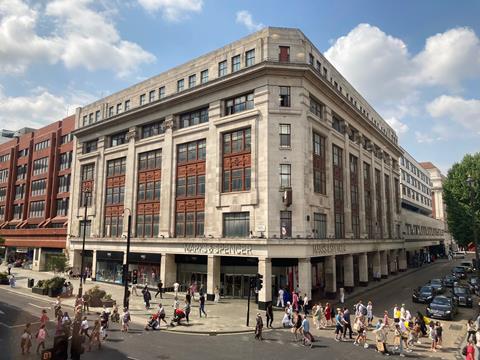We must seize this opportunity to change the course of construction, writes Henrietta Billings

SAVE Britain’s Heritage has been campaigning for the retention and re-use of existing buildings for nearly 50 years, and at first glance, the M&S building in London’s West End looks no different from many of the cases that cross our desks on a weekly basis. A handsome and re-usable historic building under threat from demolition and the hope of a lucrative planning permission.
What marks this battle out from others is that the M&S campaign breaks new ground on several fronts. It’s the first public inquiry to consider sustainability alongside heritage as a major issue. The policy and the science is also new and we are all reacting to the new climate reality.
SAVE has long advocated for the sustainable re-use of threatened buildings, but we consider the issue of carbon and embodied energy to be so relevant to our work that we decided to engage Simon Sturgis and Julie Godefroy as key sustainability experts to make the case for deep retrofit over demolition at the inquiry.
The public inquiry could not have come at a timelier moment
The urgent net zero agenda and growing public anxiety about how we treat our environment is adding pressure to the argument that a new updated approach to development is critical and required now. The M&S campaign has triggered widespread media attention, and we’ve been emboldened by the strong public support we’ve received. The public inquiry could not have come at a timelier moment.
Julia Barfield pointed out, in remarks she made to the inspector in person, how rapidly understanding of the importance of embodied carbon has changed. She said “As architects we are trained to take a brief from our client and come up with the best design response.
”The brief here [on the M&S site] was clearly to maximise the site’s potential and the architects have fulfilled their brief well – creating a building minimising operational carbon that 5/8 years ago would have been considered fine. However now that we understand the upfront impact of embodied carbon it really isn’t.”
…the M&S buildings present an ideal opporunity for a market-leading innovative comprehensive retrofit
This is a major reason that the M&S plans stick out as increasingly out of date. There is no fundamental structural, façade deterioration or safety explanation why the M&S buildings should be demolished. They are fully viable carbon assets. As we heard at the inquiry, M&S’s decision to demolish and re-build was taken in 2018 and – despite the greater understanding that now exists around embodied carbon – has not been revisited since.
M&S itself has announced an ambitious green agenda. Just in September last year the company stated it was seeking to cut a third of its carbon emissions by 2025 and to be fully net zero by 2045. In our view – as set out by Simon Sturgis at the inquiry – the M&S buildings present an ideal opporunity for a market-leading innovative comprehensive retrofit.
Here is a chance to introduce greater operational energy efficiency in the buildings; avoid the large embodied carbon emissions of demolition and re-build; achieve the desired improvements in terms of providing high-quality retail and office space and public realm; and avoid the harmful heritage impacts of the proposed new-build scheme.

M&S can be the leaders in sustainability they claim to be and commission an imaginative deep retrofit scheme, providing a pioneering example for others to follow. And SAVE isn’t alone in that view. Developers Tyler Goodwin, CEO of Seaforth Land, Jacob Loftus, CEO of General Projects, Charlie Baxter, MD of Alchemi, and Ashley Nicholson, founder of Verve Properties submitted statements to the inquiry.
So did architects and designers Sarah Wigglesworth, Julia Barfield, Ian Ritchie, Mark Hines (who led the refurbishment of BBC Broadcasting House), Michelle Ludik of HOK, David Coughtrie, Christine Humphreys, Scott Lindsay of Simpson & Brown, and Stirling Prize-winner Steve Tompkins of Haworth Tompkins. They were joined by representatives of Heritage Declares, Architects Declare and the Architects’ Climate Action Network.
Technical specialists Dr Alice Moncaster, an internationally recognised expert on the carbon impacts of construction, and Will Arnold, head of climate action at the Institute of Structural Engineers as well as art historians and academics Andrew Saint, Alan Powers and Barnabas Calder also submitted statements backing SAVE’s case.
The UK is legally committed to transition to a net-zero economy by 2050
The campaign has thrown into stark relief the need to make demolishing buildings without overwhelming evidence simply unacceptable. The buildings and construction sector is responsible for about 40% of UK carbon emissions. We lose more than 50,000 buildings a year by demolition, and construction is far more carbon-intensive than refurbishment.
The UK is legally committed to transition to a net-zero economy by 2050. Yet climate modelling shows it is important we make the biggest reduction as soon as possible, so this was updated in 2021 to commit us to the first 78% drop by 2035.
The construction of the new M&S building is expected to release just under 40,000 tonnes of C02 into the atmosphere. Carbon emissions released today have a larger environmental impact compared to those released in the future, such as through a building’s operational use, because today’s emissions are in the atmosphere and contributing to global warming for longer. Therefore, major new sources of emissions such as the construction of this proposed scheme are particularly damaging.
Demolition must be the last rather than the first resort
Our recent publication ‘Departing Stores’ shows that as our shopping habits change, so too can our landmark department stores. With imagination and determination, these ‘cathedrals of commerce’ can once again contribute to the life and vitality that our high streets are crying out for, while telling the rich and opulent history of a century of commerce. The M&S campaign demonstrates how vulnerable these buildings are and how much public affection there is for them.
Examples raised at the inquiry like IKEA moving into Top Shop at Oxford Circus, or three former department stores on Oxford Street (Debenhams, House of Fraser and John Lewis) all converting retail space no longer needed into new office space, shows how adaptable these buildings can be.
Demolition must be the last rather than the first resort. This inquiry offers the opportunity to provide a landmark decision that catches up with public opinion and one that could change the course of construction.
>> Fred Pilbrow: Why retrofit first should not be retrofit only
Postscript
Henrietta Billings MRTPI is director of SAVE Britain’s Heritage
Pilbrow & Partners, architects for M&S, have been invited to comment
















3 Readers' comments